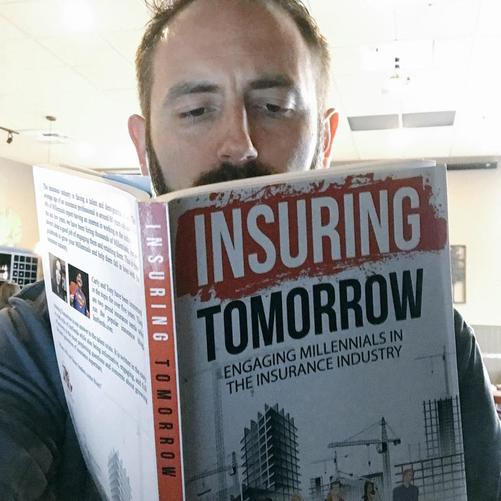 A little reading can go a long way A little reading can go a long way There is a lot of noise surrounding the term millennial. Those reading this may well have their own strong opinions about what it means to be a part of Generation Y and the distinctives of that grouping of people as it relates to the workplace. Current postings in professional sites such as LinkedIn include respected publications with headlines the likes of “Millennials are Killing Countless Industries”, numerous guides on the “keys” to understanding millennials as well as articles with headlines that include apocalyptic predictions such as “A Business Without Millennials is a Business Without a Future.” The comment sections for postings from the authors of the book Insuring Tomorrow, which we will be reviewing in this article, further illuminates the divide of opinions on this subject, while also shedding a great deal of hope as many from generations past are adapting to the current market as well as many from the up-and-coming work force are eager to learn from those who have experience in the fields they want to enter. Business leaders that are trying to stay engaged in the business game are always racking their brains. Business leaders who understand the importance of winning the talent wars are racking their brains on a whole different level as it relates to how to best understand, engage and develop the new candidates of the current workforce. While no one has the secret sauce that unravels all of the recipe intricacies of modern generations, there are many fine efforts being made to create clear and practical mediums for bridging the connection gap between leaders and millennials. Insuring Tommorrow: Engaging Millennials in the Insurance Industry is one such tool that has been put forth by the dynamic duo of Tony Canas and Carly Burnham. Before the reader shuts themselves off to another word they should understand that while this book is aimed at the insurance industry, of which the authors are practitioners and therefore most familiar, there are many applications that are relevant to any profession including parenting, instructing or just plain socializing with Generation Y. For those in a position of leadership, interacting with millennials is not a question of IF but of HOW. To coincide with the publication that we are reviewing we will utilize the definition of millennials as those born between the years of 1977-1995. Millennials are in the workforce and by many counts they are, “Already the largest generation in the workforce, and the proportion that they may up will only keep growing…by 2020, they will be 50%; and by 2025, 75% of all employees in the workforce will be Millennials (p.9).” While generational influx in talent and workforce exodus due to retirement is no new conundrum, the transition from baby boomers to millennials appears to be a stark one given the quantities of the populations involved. It doesn’t take a deep scientific study into an organization to see plainly that the talent pools in many companies are growing older while engagement, development and retention of younger candidates is an ongoing challenge. To quote the headline referenced in the opening paragraph, “A business without millennials is a business without a future.” Insuring Tomorrow is well written with a blend of personal experience, professional examples and industry relevant research to support the author’s claims. The book serves first as an outline to engaging millennials, a practical manual for specific social experiments and finally as a reference for questions that may arise as a person in a position of leadership works to develop both their professional as well as their soft skills with generational employees. A key understanding from the book is to recognize that millennials are not just a different generation but in many respect they are a different culture with unique methods of communication. An example of this from the book (p.28) draws from cultural distinctives such as removing your shoes before entering the home of a family from another culture where this would be a normative value, if those engaging with Generation Y can view millennials as a unique culture they may be able to begin to bridge the communication divide. There is a great story (p.85) about an interview that could have been a missed opportunity but because the interviewer took a few extra minutes to understand the individual they were meeting with both parties benefited from the addition of new talent to the organization. Leaders are encouraged to remember that not all millennials have received good mentorship, by giving them the benefit of the doubt with regards to lack of experience and taking the time to be clear, organizations may find the diamonds in the rough that they might otherwise glance over. Tony and Carly have some practical tips for the first day and orientation throughout their book in addition to reversing several myths about millennials including this one regarding criticism, “They’re [millennials] absolutely comfortable with getting constructive feedback, but worry much more if they get no feedback, which is what is truly demotivating for a Millennial (p 58).” Millennials, as well as those generations around them, prefer constant feedback that will help them understand and progress in their career development rather than static (annual) reviews which do not illuminate the road map to success. The authors highlight another point of confusion, responding to the criticism that many millennials appear to be traveling through organizations with greater frequency than generations past. As many as 82% of millennials view themselves as loyal even though only 1% of HR professionals would agree, yet the authors argue this is a difference in how loyalty is measured. In the second chapter of Insuring Tomorrow, they note, “Millennials have a different definition of loyalty than previous generations did. For Millennials, loyalty means, ‘I worked very hard while I was there (p. 27).” Definitions such as these may be harder to comprehend across generational lines, but leaders and employees alike may be surprised to discover that they value many of the same core principles but there is a disconnect in the manner through which they describe or express those values. Some of the highlights of the book include insights on What Millennials Look for at Work (Chapter 3), Give Constant and Honest Feedback(Chapter 7), Assume Good Intentions and Lack of Experience (Chapter 12) and Recruiting Millennials (Chapter 22). There are several practical examples including some side-by-side evaluations of the on-boarding processes (first day experience as well as orientation) for various organizations with commentary on how to improve this critical phase. Key take-aways from Insuring Tomorrow that this author will work to implement include: 1) creating flexibility at work, as this is valued by 96% of employees according to Bentley University and if structured correctly could increase productivity as well as engagement; 2) being clearer with expectations early on, “During orientation, be explicit in your expectations. Don’t assume they know anything! The biggest mistake you can make is failing to explain what you expect them to do and what goals you are going to hold them accountable for (p.101,102).”; 3) continuing to be committed to personal as well as employee development, leaders lead by example and should create opportunities for those coming behind them to excel, quoting from the Insurance Journal, “Millennials believe that training is the best way employers can demonstrate an investment in them (p.136).” Perhaps one of the simplest and most practical tips comes from Chapter 9, which is titled Ask for Their Opinions. Leaders like to have their opinions heard, and not surprisingly so do millennials employees, “When they arrive in the corporate world, they’re sorely disappointed to find that no one asks for their opinions. The simple act of being asked makes Millennials feel listened to and make it easier to become engaged in the company. It’s a free way of increasing commitment and employee happiness (p.72).” Whether those in leadership positions currently understand or enjoy working with the nuances of the coming generations, there are lessons to be learned and benefits to be reaped from expanding abilities of working with the largest sector in the current workforce. One could think of it this way - if the bulk of leaders and organizations are struggling (if not resisting) to work with millennials, those who adapt their systems earlier in the game will be ahead of the pack that will eventually be forced to do so. Tony Canas and Carly Burnham act as millennial interpreters with a specificity in their book, Insuring Tomorrow, aimed at the insurance industry. Tony and Carly both work in this field and have practical insights from their research combined with their passion and experiences that will be of great use to those in positions of leadership who are working within the insurance umbrella. Even though this book is geared towards the insurance industry, there are plenty of practical insights and examples that will be of great benefit to leaders in any industry. Insuring Tomorrow is a minimal investment of money (it’s only $19.99) and a quick read for any leader looking to grow in the area of engaging millennials regardless of the industry (227 pages). In addition to the book, the activity of the authors on social media combined with the resources available through their website Insnerds.com will be of value to leaders and millennials workers alike.
0 Comments
Leave a Reply. |
AuthorThoughts on personal and professional development. Jon Isaacson, The Intentional Restorer, is a contractor, author, and host of The DYOJO Podcast. The goal of The DYOJO is to help growth-minded restoration professionals shorten their DANG learning curve for personal and professional development. You can watch The DYOJO Podcast on YouTube on Thursdays or listen on your favorite podcast platform.
Archives
March 2023
Categories
All
<script type="text/javascript" src="//downloads.mailchimp.com/js/signup-forms/popup/unique-methods/embed.js" data-dojo-config="usePlainJson: true, isDebug: false"></script><script type="text/javascript">window.dojoRequire(["mojo/signup-forms/Loader"], function(L) { L.start({"baseUrl":"mc.us5.list-manage.com","uuid":"b9016446bd3c6a9f0bd835d4e","lid":"83282ffb9e","uniqueMethods":true}) })</script>
|
Jon Isaacson |
Connect. Collaborate. Conquer.
© COPYRIGHT 2015. ALL RIGHTS RESERVED.
|



 RSS Feed
RSS Feed